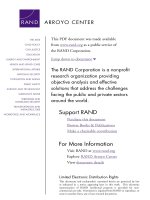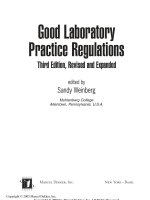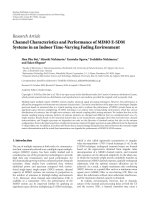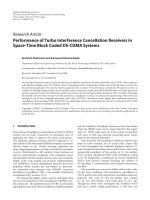Current situation about performance of good pharmacy practice regulations in the central city and the Northern mountainous area
Bạn đang xem bản rút gọn của tài liệu. Xem và tải ngay bản đầy đủ của tài liệu tại đây (123.34 KB, 7 trang )
Journal of military pharmaco-medicine no9-2019
CURRENT SITUATION ABOUT PERFORMANCE OF GOOD
PHARMACY PRACTICE REGULATIONS IN THE CENTRAL CITY AND
THE NORTHERN MOUNTAINOUS AREA
Nguyen Van Thuan1; Nguyen Thanh Binh2; Phan Thi Hoa3; Ngo Xuan Trinh3
SUMMARY
Objectives: To describe the status of compliance with a number of good pharmacy practice
regulations of pharmacies in the central cities and the Northern mountainous area (2017 2018). Subjects and methods: Cross-sectional description. The sample size included
80 pharmacies (40 pharmacies in central cities and 40 pharmacies in mountainous area).
Collect data on evaluating compliance with a number of good pharmacy practice regulations
through observation of designed checklists. Results: The implementation of personnel
regulations: The proportion of pharmacies in two regions reached a low rate (5.0 - 56.3%).
Pharmacy facilities reached a good rate (57.5 - 98.8%). Equipment stored at drugstores had a
low use rate (with equipment: 85.0 - 98.8%; active equipment: 20.0 - 77.5%). Books and records
at drugstores reached low use rate (records: 85.9 - 96.2%; complete records and tracking: 17.9
- 96.2%). Arrangement in display and storage areas had a low rate (37.5 - 63.8%). The average
point of implementing some good pharmacy practice regulations of central pharmacies (16.1 ±
2.89) was higher than that of mountainous pharmacies (14.73 ± 2.43). The difference was
statistically significant (p < 0.05). Conclusion: The percentage of pharmacies in two regions that
complied with good pharmacy practice was generally low. Central city pharmacies complied with
regulations on good pharmacy practice higher than those in mountainous areas. Therefore,
when building measures to improve good pharmacy practice scores, more attention should be
paid to pharmacies in mountainous areas.
* Keywords: Good pharmacy practice; Mountainous areas; Central cities.
INTRODUCTION
The retail pharmacies in the community
can be considered as a "grassroots health
unit", play an important role in the system
of direct drug supply to the people,
meeting the rising needs of the
community about primary health care.
Besides, when people have health
problems, most of them choose pharmacy
is the first place to go [5]. According to the
report of the Vietnam Drug Administration
in 2010, when people suffered from any
health problems, especially common
diseases, 60 - 85% of them often have
visited drugstores to seek help and
medication, before coming to other types
of health services [1].
1. 175 Military Hospital
2. Hanoi University of Pharmacy
3. Vietnam Military Medical University
Coresponding author: Nguyen Van Thuan ()
Date received: 20/10/2019
Date accepted: 26/11/2019
188
Journal of military pharmaco-medicine no9-2019
However, the professional practice of
drug retailers in our country is still
inadequate, such as selling over-thecounter medicines, substance abuse,
antibiotics, corticosteroids, vitamins... To
overcome the inadequacies in the quality
of pharmacy practice, since 2007, the
Vietnam Ministry of Health had published
a document of Decision No.11/2007/QD-BYT
promulgating the principles and standards
of "Good pharmacy practice” (GPP) [2].
Nevertheless, there are currently many
opinions that the granting of GPP in our
country is only "formal" outside. The
question is whether pharmacies will
continue to be guaranteed as the result
of the initial GPP assessment?. The
maintenance of facilities, drug storage
conditions as prescribed, the monitoring
and supervision of the quality of drugs
purchased at drugstores as well as the
quality of drug supply to people and what
is the difference between pharmacies in
the central cities and mountainous areas?.
Therefore, this research was conducted
with main objective: To describe the
current situation about performance of
good pharmacy practice regulations in the
central cities and the northern mountainous
area (2017 - 2018).
SUBJECTS AND METHODS
1. Subjects, location and time of
study.
- Subjects: Pharmacies meet GPP
standards and are still doing business
(excluding private pharmacies within
hospitals, district health stations, general
clinics in the study area; not belonging to
pharmacies that sell traditional medicines
and medical materials).
- Location of study: The study was
conducted in 4 provinces and cities:
Hanoi and Haiphong represented for the
central cities; Tuyenquang and Dienbien
represented for the Northern mountainous
area.
- Time of study: From 01 - 2017 to
01 - 2018.
2. Methods.
* Study design: The cross-sectional
descriptive method.
* Sample size and sample selection:
20 pharmacies were chosen in each
province/city. Specific pharmacies in each
province/city were selected by using the
simple random method from the list of
pharmacies which was provided by the
Department of Health of the studied
provinces/cities. Total: 80 pharmacies.
* Methods and techniques for data
collection:
Investigators observe directly at
drugstores (drug retailers) and use
checklists to assess facilities, equipment
and practice regulations (personnel,
prescription, and labeling) follow the GPP
principle.
* Data processing methods:
The information collection forms were
checked, cleaned, processed and entered
by using Excel software. Information was
analyzed by descriptive statistical technique.
Compare the differences between the two
ratios via the index p.
* Research ethics:
The study was reviewed and approved
of the Department of Health in researched
provinces. Owners of pharmacies were
fully explained about the content and
189
Journal of military pharmaco-medicine no9-2019
purpose of the study. All study subjects
confirmed voluntary participation. All
pharmacy informations were kept
confidentially and were for research
purposes only, not for other purposes.
RESULTS AND DISCUSSION
Subsequently, the International Federation
of Pharmaceuticals had developed a GPP
guide on the basis of drawing on practical
experiences in the use of drugs by
countries throughout the territory and by
international pharmaceutical organizations
[4].
The concept of GPP was first conceived
at the Conference in Tokyo (1993) by the
International Pharmaceutical Federation
(FIP): A good practice drugstore is a
pharmacy that does not consider benefits
profits of their own business but also
interested in the interests of buyers, the
common interests of the whole society.
In Vietnam, GPP is a document that
sets out basic principles and standards in
professional practice at pharmacies of
pharmacists and pharmaceutical personnel
on a voluntary basis adhere to ethical and
professional standards at a level higher
than the minimum legal requirements [3].
1. Results of investigation on implementing personnel regulations in two areas.
Table 1: Implementing personnel regulation.
Pharmacies of
central city area
(n = 40) (%)
Pharmacies of
mountainous area
(n = 40) (%)
p
Total
(n = 80) (%)
Professional manager
presents at the pharmacy
9 (22.5)
4 (10)
0.225
13 (16.3)
The drug seller wears a blouse
26 (65.0)
19 (47.5)
0.176
45 (56.3)
The drug seller wears a
signboard
4 (10.0)
0
0.116
4 (5.0)
Personnel regulations
One of the first contents of the
pharmacy good practice standard is
personnel. The results of our research
showed that the proportion of professional
managers present at drugstores, blousewearing drug sellers and drug vendors
wearing signboards of pharmacies in
central city area was higher than that
in the moutainous area. However,
this difference was not statistically
significant (p > 0.05). The percentage of
professionals present at the pharmacy for
190
both groups was higher than the result
of a survey of 371 pharmacies in
3 major cities of Pakistan in 2012, when
the authors pointed out, 2.2% of
pharmacies had pharmacists who sold
directly [6]. Based on this, it can be
seen that pharmacists or professional
staff present at pharmacies was very low,
which can cause many difficulties for
customers such as not buying the
right medicine or not being consulted
carefully.
Journal of military pharmaco-medicine no9-2019
2. Results of investigation on implementing regulations on maintaining
material facility standards at pharmacies in two areas.
Table 2: Implementing on maintaining material facility standards at pharmacies.
Pharmacies of
central city area
(n = 40) (%)
Pharmacies of
mountainous area
(n = 40) (%)
p
Total
(n = 80) (%)
Consulting area
34 (85.0)
37 (92.5)
0.481
71 (88.8)
Hand-washing area
25 (62.5)
21 (52.5)
0.498
46 (57.5)
Dispensing drug area
33 (82.5)
38 (95.0)
0.154
71 (88.8)
Private area for cosmetics,
functional foods
39 (97.5)
40 (100)
0.241
79 (98.8)
Regulations
Among the four regulations to maintain
standards of drugstores' facilities and
regulations, the private areas for cosmetic
and functional foods to be served was
the highest proportion; regulations for
hand-washing was the lowest incidence
(57.5%). The difference in the compliance
rate between the two regions was not
statistically significant (p > 0.05).
The results showed that the proportion
of drugstores in mountainous areas
maintained standards in counseling areas,
drug dispensing areas and separate areas
for cosmetics and functional foods were
very high, even higher than pharmacies in
the central city area. Only hand-washing
area in pharmacies of central cities had a
higher rate of maintaining standard of
facilities than that in mountainous area.
However, these differences were not
statistically significant (p > 0.05). Of all
areas, hand-washing areas had the lowest
rates of pharmacies upholding the standard.
This was also a point to be noted for
improvement, because adequate and
proper hand hygiene was one of the
measures to prevent cross-contamination
from person to person.
3. Results of investigation on implementing regulations on maintaining
storage equipments standards at pharmacies in two areas.
Table 3: Implementing on maintaining storage equipments standards at pharmacies.
Regulations
Pharmacies of
central city area
(n = 40) (%)
Pharmacies of
mountainous area
(n = 40) (%)
Total
(n = 80) (%)
p
Having
(1)
Activity
(2)
Having
(3)
Activity
(4)
p (1-3)
p (2-4)
Having
Activity
Air conditioner
39
(97.5)
7 (17.5)
40
(100)
9 (22.5)
1.00
0.781
79
(98.8)
16
(20.0)
Hygrothermometer
40
(100)
31
(77.5)
36 (90)
24
(60.0)
0.116
0.147
76
(95.0)
55
(68.8)
191
Journal of military pharmaco-medicine no9-2019
Tools to
dispense drugs
35
(87.5)
32
(80.0)
38
(95.0)
30
(75.0)
0.432
0.790
73
(91.3)
62
(77.5)
Measures to
avoid sunlight
32
(80.0)
-
36
(90.0)
-
0.348
-
68
(85.0)
-
Of the 4 regulations that maintain the
standards of equipment for storage at
the pharmacy, 3 regulations (air
conditioners, hygro-thermometers and
dispensers) were subjected (both
equipment and operating at the time of
study). However, the ratio of setting up
equipment was not commensurate with
the proportion of equipment in operation
mode. The proportion of central cities
and mountainous drugstores with
air-conditioners, hygrometer sets, retailing
devices, measures to avoid the sunlight
was quite high (≥ 80%). However, with
the current status of operation, the
regulation of operation in pharmacies in
mountainous areas was higher than
pharmacies of central city area, but the
rate was quite low. The rate of operation
of hygro-thermometer, and the number
of retail dispensers of central city
pharmacies was higher than in the
mountainous areas. However, the
difference was not statistically significant
(p > 0.05). As for the method of avoiding
sunlight, 85% of pharmacies were
equipped but all pharmacies did not use
this method. Preserving facilities is very
important and necessary to avoid adverse
effects from the environment. A situation
that can be seen in pharmacies was that
even though they had such equipments,
the rate of operation was quite low.
Therefore, pharmacies should have
regular maintenance and repair to ensure
the operation of drug storage equipment.
4. Results of investigation on implementing regulations on documents and
records at pharmacies in two areas.
Table 4: Implementing regulations on books and records.
Regulations
Pharmacies of
central city area
(n = 40) (%)
Having
(1)
Patient monitoring
book
Drug receive/deliver
monitoring book
ADR tracking book
Temperature,
humidity monitoring
book
192
38
(95.0)
38
(95.0)
33
(82.5)
35
(87.5)
Recording
(2)
27 (67.5)
38 (95.0)
9 (22.5)
28 (70.0)
Pharmacies of
mountainous area
(n = 40) (%)
Having
(3)
34
(85.0)
37
(92.5)
34
(85.0)
35
(87.5)
Total
(n = 80) (%)
p
Recording
p (1-3)
(4)
p (2-4)
Having Recording
9 (22.5)
0.263 < 0.001
72
(92.3)
36 (46.2)
37 (92.5)
1.00
1.00
75
(96.2)
75 (96.2)
5 (12.5)
1.00
0.378
67
(85.9)
14 (17.9)
29 (72.5)
1.00
1.00
70
(89.7)
57 (73.1)
Journal of military pharmaco-medicine no9-2019
Of the 4 regulations on documents and records at the drugstore, 96.2% of the
pharmacies fully implemented both regulations (monitoring books and full records).
Regulations on ADR monitoring books had the lowest percentage of pharmacies.
Regarding the regulations on patient monitoring book, there was a clear difference in
the percentage of pharmacies that complied with the full record between the two areas.
The difference was statistically significant (p < 0.001)
5. Results of investigation on implementing regulations on display and
storage zones arrangement at pharmacies in two areas.
Table 5: Implementing display and storage zones at pharmacies.
Pharmacies of
central city area
(n = 40) (%)
Pharmacies of
mountainous area
(n = 40) (%)
p
Total
(n = 80) (%)
Proper arrangement of
cosmetics, functional foods
30 (77.0)
21 (52.5)
0.787
51 (63.8)
Proper arrangement of over-thecounter/prescription medications
19 (47.5)
11 (27.5)
0.105
30 (37.5)
Regulations
The proportion of central pharmacies that properly arranged functional food
cosmetics and the right arrangement of over-the-counter/prescription drugs was higher
than that of the drugstores in mountainous areas. The difference in the proportion of
pharmacies that complied with regulations between the two regions was not statistically
significant (p > 0.05). It can be seen that pharmacies in mountainous areas were
currently not implemented. Our results were similar to a study conducted on some of
the Northern provinces such as Hanoi, Vinhphuc, Nghean and Thanhhoa.
Assessments of the practice of pharmacies have shown that in practice, according to
the inspection results at GPP pharmacies in Hanoi in the period of 2010 - 2012, there
were still many inadequate bookkeeping: there were more than 50% of pharmacies
recording incomplete books, not according to regulations. Between 5 - 7% of pharmacies
did not carry out bookkeeping. It is necessary to remedy this at pharmacies.
6. Average score of the GPP regulations implementation at two pharmacy
groups in two areas.
Figure 1: Average score of implementing some GPP regulations (p = 0.024).
193
Journal of military pharmaco-medicine no9-2019
The average point of implementing a
number of GPP regulations of the
pharmacies in central city was 16.1 ±
2.89, higher than that in the mountainous
area (14.73 ± 2.43). The difference was
statistically significant (p < 0.05).
As can be seen, pharmacies in
mountainous areas tend to comply with
regulations on good pharmacy practice
not yet equal to those of the central city.
Therefore, when developing measures to
improve GPP points, more attention should
be paid to pharmacies in mountainous
areas.
CONCLUSION
The pharmacies of the two regions had
complied with regulations on GPP: The
proportion of personnel was low (5.0 to
56.3%), in terms of pharmacy facilities the
rate was quite good (57.5 to 98.8%),
about the equipment used in drugstores
storage at the low actual utilization rate
(with storage facilities: 85.0 - 98.8%;
operating equipment: 20.0 - 77.5%),
records at the drugstore achieved a low
rate of use (with records: 85.9 - 96.2%;
complete records and tracking: 17.9 96.2%), the rate of arrangement in the
display and storage area was low (37.5 63.8%). The average point of implementing
194
some GPP regulations of central city
pharmacies (16.1 ± 2.89) was higher than
that of mountainous pharmacies (14.73 ±
2.43). The difference was statistically
significant (p < 0.05).
REFERENCES
1. Drug Administration, Ministry of Health.
Pharmaceutical Industry Report 2010. Hanoi.
2010.
2. Ministry of Health. Decision on promulgating
principles and standards of "good pharmacy
practice". No.11/2007/QD-BYT dated 24/01/2007.
Hanoi. 2007.
3. Ministry of Health. Circular prescribing
good practices of drug retail establishments.
02/2018/TT-BYT dated January 22, 2018.
Hanoi. 2018.
4. International Pharmaceutical Federation.
Guidelines on good pharmacy practice: Standards
for quality of pharmacy services. 1993.
5. Muhammad Haroon Sarwar, Muhammad
Farhan Sarwar, Muhammad TaimoorKhalid
et al. The roles of pharmacy and clinical
pharmacy in providing health care services to
the people. Research & Reviews in Pharmacy
and Pharmaceutical Sciences. 2015.
6. Hussain A, Ibrahim M.I. Medication
counselling and dispensing practices at
community pharmacies: A comparative crosssectional study from Pakistan. J Clin Pharm.
2011, 33 (5), pp.859-867.









